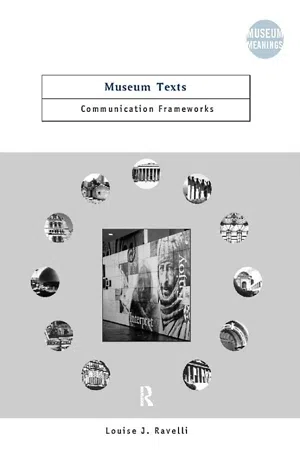
- 200 pages
- English
- ePUB (mobile friendly)
- Available on iOS & Android
About this book
Answering key questions in the study of how museums communicate, Louise Ravelli provides a set of frameworks to investigate the complexities of communication in museums:
* What is an appropriate level of complexity for a written label?
* Why do some choice in language make a more direct relation to visitors?
* Is there a correct way of presenting a particular view of content?
* How do design practices contribute to the overall meanings being made?
The frameworks enhance the way we critically analyze and understand museums text, both in the sense of conventional – written texts in museums – and in an expanded sense of the museum as a whole operating as a communicative text.
Using a wide range of examples Ravelli argues that communication contributes fundamentally to what a museum is, who it relates to and what it stands for.
Not only museum studies and communications studies students, but also professionals in the field will find Museum Texts an indispensable guide on communication frameworks.
Frequently asked questions
- Essential is ideal for learners and professionals who enjoy exploring a wide range of subjects. Access the Essential Library with 800,000+ trusted titles and best-sellers across business, personal growth, and the humanities. Includes unlimited reading time and Standard Read Aloud voice.
- Complete: Perfect for advanced learners and researchers needing full, unrestricted access. Unlock 1.4M+ books across hundreds of subjects, including academic and specialized titles. The Complete Plan also includes advanced features like Premium Read Aloud and Research Assistant.
Please note we cannot support devices running on iOS 13 and Android 7 or earlier. Learn more about using the app.
Information
Table of contents
- Cover Page
- Museum Texts
- Museum Meanings
- Title Page
- Copyright Page
- Illustrations
- Acknowledgements
- Illustration and text sources
- 1: Introduction
- 2: Organisation as a way of making meaning
- 3: Focus
- 4: Interacting in and through language
- 5: Representing the world through language
- 6: Extending the frameworks
- 7: Conclusion
- Notes
- Bibliography